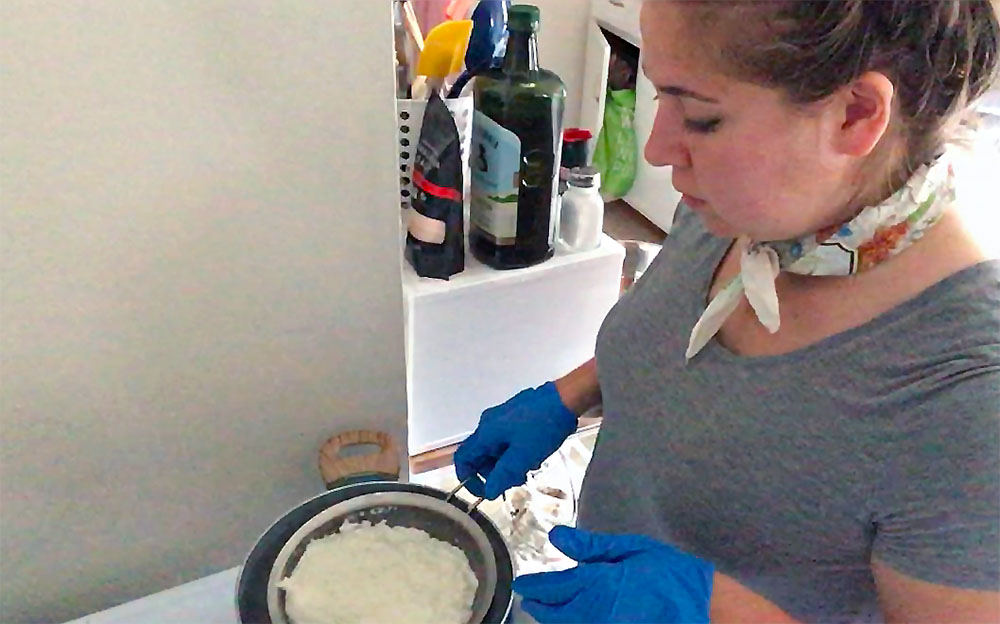I tried making mozzarella from scratch. Here’s how it went.
I love mozzarella. I love it melted over hot pizza, doused with olive oil in caprese salad and sprinkled with breadcrumbs in eggplant parmesan. I could eat a hunk of mozzarella like an apple if I weren’t worried about the gastrointestinal ramifications. When it comes to making mozzarella, though, I have been completely ignorant — until now.

At the Maine Organic Farmers and Gardeners Association’s Farm and Homestead Day, I was drawn to the cheesemaking workshop like a siren’s song. The instructors led curious onlookers through the process of turning an entire vat of milk into a single fistful of shiny, springy cheese. They broke off warm chunks for everyone to sample. It was luscious, pillow, heavenly — like a kiss from a lactic angel.
I decided then and there that I had to try making mozzarella myself.
![]()
Volunteer workshop leader Linda Maclachlan making mozzarella during a cheesemaking workshop at the Maine Organic Farmers and Gardeners Association’s annual Farm and Homestead Day in 2019. | Photo by Sam Schipani 
Volunteer workshop leader Linda Maclachlan making mozzarella during a cheesemaking workshop at the Maine Organic Farmers and Gardeners Association’s annual Farm and Homestead Day in 2019. | Photo by Sam Schipani
Between pressing, ripening and selecting one of the many molds and bacteria that are added to different cheese to give each a unique flavor, cheesemaking can take a lifetime to master. Mozzarella, however, is one of the simplest, fastest cheeses to make, so it is great for first-time cheesemakers like me. I’m just lucky that it’s also one of my favorites.
Mozzarella originates from the Gulf of Naples. My family hails from a little further south in Italy (“Schipani is like Smith in Calabria,” my father once told me), but I hoped I could channel my Southern Italian heritage into innate mozzarella making prowess regardless.
Making mozzarella requires precision in temperature and timing. When it comes to forming the cheese, many cheese artisans rely on experience and intuition to determine whether the cheese is at the right stage of development and consistency.
Learning to try
To start, I picked this homemade mozzarella recipe from Epicurious. The instructions seemed simple, and I knew where I could get all the ingredients listed.
First, milk. Mozzarella is traditionally made from water buffalo milk, but whole milk will do in a pinch. Because whole milk contains more butterfat, it will produce a greater quantity of more flavorful cheese than its lower-fat counterparts (though skim milk is used to make some hard cheeses).
That said, almost any milk can be used for making mozzarella. At Farm and Homestead Day, the cheesemaking workshop leaders used fresh goat milk. Even pasteurized milk is fine to use, but make sure that it is not ultra-high temperature, or UHT, pasteurized (usually, this is reserved for products that need to be super shelf-stable, like coffee creamer, so you should be fine with your favorite store-bought brand).
Next, citric acid. You can buy citric acid at most big box stores like Target and Walmart (it should be in the same aisle as spices and seasonings, or alongside canning materials) or purchase it online. The weak acid, which is sold as a powder, helps with flavor, melting and preventing contamination in cheese. Milk will naturally acidify over time, but citric acid controls the breakdown of the milk so it ripens deliciously instead of going sour.
Believe it or not, I already had a bag of citric acid on-hand. What can I say? It’s a handy compound for curious DIYers that can be used for everything from canning to candy-making!
Finally, liquid rennet. I would guess that like most first-time cheesemakers, I did not have this one sitting around in my refrigerator.
Rennet is a thickening agent that contains an enzyme called chymosin, which is found in the stomach lining of cows, goats and sheep to help them digest milk. Plant-based rennets derived from plants like artichoke, nettle and thistle have enzymes similar to chymosin, but animal rennet is generally easier to work with.
Fun fact: cheesemakers are not required to disclose whether they work with animal-based or plant-based chymosin. Vegetarians, beware!
You can purchase liquid rennet at a cheesemaking shop, health food store or online. I visited Central Street Farmhouse in Downtown Bangor for a 2-ounce bottle, which costs under $10. You only need a tiny bit, so I plan to use my bottle for several follow-up cheesemaking sessions.
Another materials-gathering note: choose your pot wisely. The pot will need to be non-reactive — no aluminum, cast iron or copper — or else it will do funky things to your cheesy (and not a good kind of funky, either). Stainless steel pots with heavy bottoms are best.

A trying experience
In the early stages, making mozzarella seems like an endless process of heating, reheating and taking the temperature of a slowly curdling — but otherwise unremarkable — pot of milk.
The moment when that mesh sieve emerged from the pot with filled with creamy, jiggly white curds, I felt more like a magician than an amateur cheesemaker (though I struggled to find a strainer that was large enough to capture curds, but small enough to maneuver around the pot to make sure I scooped up all the cheesy goodness).
My main advice for new mozzarella makers is not to get frustrated if the cheese isn’t forming right away. Just keep folding, squeezing and heating the cheese. Eventually, it will (probably) come together. If you get frustrated and give up, all your efforts (and your perfectly good curds) could go to waste.
Also, get good gloves. I used run-of-the-mill blue nitrile gloves and found them lacking. The mozzarella was so hot, I had a little bit of trouble handling it.
And don’t be shy with salt! The exact amount you use will depend on how salty you like your mozzarella. I used about 1 ½ teaspoons, but I’d recommend using a little more.
Stretching mozzarella is delightful. It reminded me of my Play-doh days (I was equally tempted munch on the warm mozz’ as I was to stuff Play-doh in my mouth as a preschooler, too). I am big enough of a person to admit, though, that I was a timid stretcher. I was too afraid of my whole cheese crumbling apart to get those beautiful, elongated stretches executed by professional cheesemakers. With practice, I hope I’ll get there, too.
My tried-and-true takeaways
Maybe it’s the cheesemaking novice in me speaking, but I saw making mozzarella, with all its precisely-measured liquid solutions, careful timing and exact temperature readings, as more of a science than an art. Next time, with the various stages of development fresh in my mind, perhaps I can focus more on the artistry.
For now, though, I made a delicious caprese salad with my mozzarella, along with basil and tomatoes that I grew in my community garden. My Nonna would be proud.


We also love mozzarella! I would not try making it myself, but I enjoy your adventure, how you write & not the least, your facial expressions! Keep on trying!